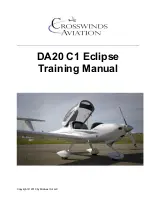
15
Big ears
Big ears are the simplest method for rapid descent. The advantage is that the horizontal
speed is higher than the sink rate (3-5 m/s), unlike a spiral dive or a B-line stall. This rapid
descent technique is used to quickly and horizontally exit a dangerous area in the desired
direction. It is even possible to land using big ears (for example top-landing).
In order to collapse the outermost part of the wing, pull the A1-risers down. The Elan 3
easily tucks the wingtips and enters a stable descent mode. The pilot keeps hold of the
brake handles along with the A1-risers in his hands. By braking on one side and weight-
shifting, the canopy remains steerable. In order to increase the sink rate as well as the
horizontal speed, this manoeuvre should be done together with use of the speed system.
Apply the speed system after big ears are induced (step into the speed-bar before you
grab the outer A1-risers). Big ears substantially reduce the risk of canopy stability problems
in turbulent air. To exit big ears release the A1-risers. The canopy does very slowly self-
recover. To quicken the recovery, the pilot can dynamically pull down and immediately
release the brakes of the glider.
WARNING! Never do big ears in spirals, as this may drastically reduce the number of lines
taking the already high loads, causing structural failure.
B-line stall
The B-stall is a stall descent technique where the canopy’s aerofoils are deformed by
pulling the row of B lines down. The paraglider sinks vertically with a sink rate of approx.
7-8 m/s.
To induce a B-line stall symmetrically pull down slowly on both B-risers, until the canopy
folds (parallel to its long axis). The airflow over the top surface is almost fully detached and
the canopy enters a vertical descent flight mode without forward movement. Further pulling
of the B-risers reduces the surface area more and increases the sink rate. Be careful,
pulling too far or too rapidly may cause a frontal horseshoe to form. To exit from this flight
mode release the B-risers at first rapidly but then gently (1 sec). The canopy surges
forward re-attaching the airflow over the top surface and resumes normal flight. When the
B-risers are released, the brakes should not be activated. This will give the canopy the
chance to gain speed and resume normal flight. On exit from a B-line stall on no account
just release the B-risers, as this can cause overloading. If canopy does not recover apply
both brakes gently to recover or pull the A-risers, until the canopy regains forward speed.
Attention! The canopy surges forward after B-risers have been released until the airflow
reattached. To prolong lifetime of your glider we don't recommend B-Stall as a usual
descent technique.
Attention! All rapid descent techniques should first be practised in calm air and with
sufficient height so the pilot can use them in emergency situations! By far the best
technique is to fly correctly and safely, so you never have to descend rapidly!
Содержание elan3
Страница 1: ...1 ...
Страница 31: ...31 LINE PLAN ELAN 3 ...
Страница 34: ...34 CHECKS Name Company Date Signature Stamp ...
Страница 36: ...36 ...
Страница 37: ...1 ...
Страница 70: ...34 PLAN DE SUSPENTESELAN 3 ...
Страница 74: ...38 CONTROLES Nom Entreprise Date Signature et cachet ...
Страница 76: ...40 ...















































